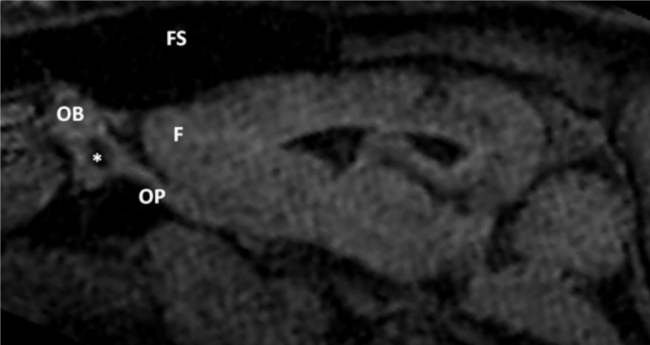Introduction
Capybara belongs to the order Rodentia, and it has peculiar brain features such as the elongated olfactory bulb. This structure is attached to the cerebral hemisphere by the olfactory peduncle. The bulb and peduncle are hollow, containing an olfactory ventricle filled with cerebrospinal fluid.
Objectives
The aim of this partial study is to describe the olfactory bulb in living capybara by means of MRI providing more detailed information of intracranial structures of this species, for research centers and clinics of wild animal veterinary medicine.
Methods
Eight adult capybaras were submitted to MRI examination using a 0.25 Tesla equipment (Vet-Grande; Esaote, Italy), under general anesthesia using face mask. The olfactory bulbs were evaluated by T1W, T2W and FLAIR sequences on the transverse, sagittal and dorsal planes. Olfactory ventricle area was measured on the T1W transverse planes.
Results
Olfactory bulbs are wide, extending rostrally from the cranial cavity, and they are attached to the cerebrum by long tube structures, which are the olfactory peduncles. In the middle-central portion of the olfactory bulb, fluid content can be noted representing the rostral horn of the lateral ventricle (Figure 1), or olfactory ventricle. The olfactory ventricle area ranged from 0–0.075 cm2 to the right (mean, 0.035 cm2; SD=0.021) and from 0–0.055 cm2 to the left (mean, 0.032 cm2; SD=0.018).
| Figure 1 | 
T1-weighted, 1-mm thick, right sagittal MRI showing the elongated olfactory bulb (OB) attached to the cerebrum by the olfactory peduncle (OP). The olfactory ventricle (asterisk) is noted within the OB by the fluid content. FS=frontal sinus; F=frontal lobe |
|
| |
Conclusions
While dogs and cats have a short olfactory bulb, capybaras have an elongated olfactory bulb and slightly separated from the brain. These structures can be compared with horse brain, which also has visible olfactory ventricle.